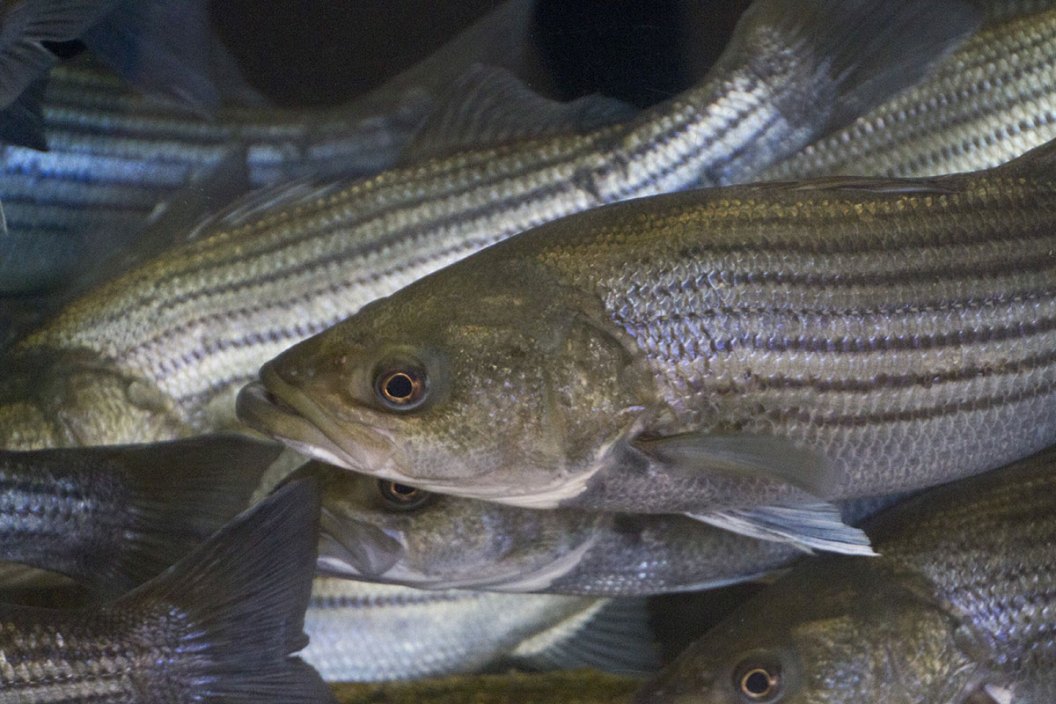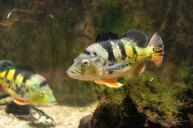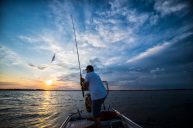The striped bass is one of our most important game fish species, and it almost didn't make it.
Striped bass can be used as a term for a couple different types of fish, depending on where you live.
For our purposes here, we'll stick to the natural, ocean run fish that spend their adult lives in saltwater before returning to freshwater tributaries to spawn.
Unfortunately, there was a time when striped bass (Morone saxatilis) experienced a serious threat to their population's longevity and sustainability.
According to the U.S. Fish & Wildlife Service, "Atlantic coast striped bass populations suffered a major collapse shortly after commercial landings of Atlantic coast striped bass peaked in 1973 at more than 6,000,000 metric tons. Additional factors contributing to the stock collapse beside commercial overharvest were habitat loss and the construction of fish passage barriers such as dams that prevented striped bass from reaching their spawning grounds."
This nearly decimated a profoundly important fish species, not only for the use as a food source, but for sport fishing enthusiasts everywhere. Now we have the Atlantic States Marine Fisheries Commission (ASMFC), and through smart management plans for commercial and recreational fisheries set forth by the Atlantic Coast Striped Bass Fishery Management Plan, the future of Atlantic coast striped bass populations within the U.S. looks brighter.
Atlantic Coast striped bass are now considered the poster child for successful fishery management in the United States and beyond. Let's take a closer look at the species and learn how to hook up with one.
Striped Bass
Often called stripers, linesiders or rockfish, these fish are a silvery, almost black and white fish on the sides and white on the belly, with seven or eight uninterrupted horizontal lines on each side of their body.
As most already know, hybrid striped bass are a cross between stripers and white bass and can be distinguished from the naturally occurring striped bass brethren by broken rather than solid horizontal stripes on their bodies.
Where They Live
Striped bass range in the Atlantic Ocean from the Canadian part of the St. Lawrence River all the way to the Chesapeake Bay, south to the St. John River in northern Florida, and around the corner into the northern Gulf of Mexico.
A separate strain of striped bass is found extending from the fresh and brackish tributaries of western Florida into Louisiana, but these are genetically different from their Atlantic cousins.
Size
An average adult striped bass can be as little as 20 inches in length but are known to reach a whopping four feet or more on occasion. These fish typically weigh a few pounds, but veteran anglers off the East Coast routinely grab stripers that are in the 50-pound or more range.
The world record striper by weight is the IGFA record at 81 pounds, 14 ounces. That fish was caught in Long Island Sound, Westbrook, Connecticut in August of 2011.
What They Eat
Striped bass are opportunistic and voracious predators of crustaceans, small fish, and eels throughout their lives.
Striped bass juveniles feed on small shrimps and other crustaceans, worms and certain insects. Upon reaching adulthood on the Atlantic coast, Atlantic menhaden become their primary forage species, while also feeding on alewives, herring, smelt, eels, and flounders.
As the USFWS states,
Striped bass are the largest of the temperate basses. They are also anadromous, spending their adult lives in the ocean and then returning to freshwater tributaries to spawn. Young striped bass remain in streams and estuaries as they grow, and usually enter salt water before the first winter after they hatched.
Catching Stripers
Veteran striper fishermen like to say learning to fish for striped bass is akin to "earning your stripers."
Like most predator fish species, stripers feed aggressively at dawn and dusk, and also quite well after dark. When in saltwater, stripers tend to ease up onto shallow flats with a rising tide and retreat to main channels and deeper water on the ebb. They can be caught in a wide variety of water temperatures.
Striped bass are attracted to such structure as rock piles, bridge abutments, points, and drop-offs since they are all potential ambush points. Big stripers are often caught on full moon and new moon tides when a strong current favors these powerful predators in prime feeding areas.
While the biggest striped bass are most often targeted with live baits such as eels and menhaden, schools running shallow and tight to the shore can be fooled by a wide variety of lures and other artificial baits.
Most striper fishing is probably done by boat, but surf fishing for striped bass is one of the most iconic ways to put a rockfish on the shore. Using both live bait and casting, surf fishermen can set up anywhere that has access to the beach with spoons, stickbaits, live eels, bunker, shad, or clams.
Since surf fishing is always better done with a friend, one basic rule for beach fishing stripers is that if the bait fishing is slow, take turns watching the rods while the other angler moves to the side and throws plugs, spoons, or even a bucktail jig.
There is usually no need to shift positions too much as the stripers are always on the move.
Striper Fishing Gear
Surf Fishing
Depending on the conditions the angler can use a two-ounce weight all the way up to four or five to get the bait into the strike zone. Some surf fishermen will tell you that during a rough day, some types of anchors or weights will dig into the sandy bottom and can become very difficult to remove.
Veteran surf anglers recommend an eight to at least a ten-foot rod length accompanied by a smooth drag reel that can handle a good amount of 30- to 50-pound braided line. Most manufacturers have a distinctly saltwater-ready system of reels that can handle big fish along with being rinsed and cleaned easily when necessary.
Sand spikes, or rod holders that burrow into the sand, make surf fishing with live bait quite simple and allows the angler to use multiple rigs. Make sure to check your local regulations as to the amount of rods each angler can use. One thing to remember with sand spikes is that you get what you pay for since some higher cost brands are much better at digging into the beach and holding.
When casting for stripers, popping plugs, large stickbaits, bucktails, and surf tins (surf fishing term for spoons) are what put big stripers on the shore.
Boat Fishing
For boats, you're still going to want a rod in the seven to eight-foot length region to handle big fish that can run like crazy. Medium to medium-heavy action seems to be the choice of most striper hunters with Penn, Daiwa, Shimano, and Quantum all making saltwater reels that can are very sensitive and have excellent lifting power.
A three-foot fluorocarbon leader with a heavy barrel swivel works for both surf and boat fishing with live bait to fool wary fish right to the hook. Circle hooks are the very best at placing the hook into the corner of a fish's mouth, especially when slot limit stripers need to be released unharmed.
The Iconic Striped Bass
We love fishing for stripers, but in a strange way that's part of what threatened their well being. Overfishing for the Atlantic striped bass almost kept them out of the hand of sportfishermen forever. But thanks to quality striped bass stock assessment and striped bass management, this game fish is well defended for anglers from Massachusetts to North Carolina and beyond.
This anadromous fish that lives in saltwater but breeds in freshwater is now a part of a management plan that protects vulnerable nursery areas. That way this important game fish species is always available to anglers everywhere.
Striped bass fishing is not only one of the most important targets for recreational anglers, but for the economies of the coastal states where they thrive. In other words, they're well worth saving.
Looking for a little more or even hot lunch for your hunting blind? Follow my webpage, or on Facebook and YouTube.
NEXT: THE TOP 10 STATES FOR BASS FISHING
WATCH




